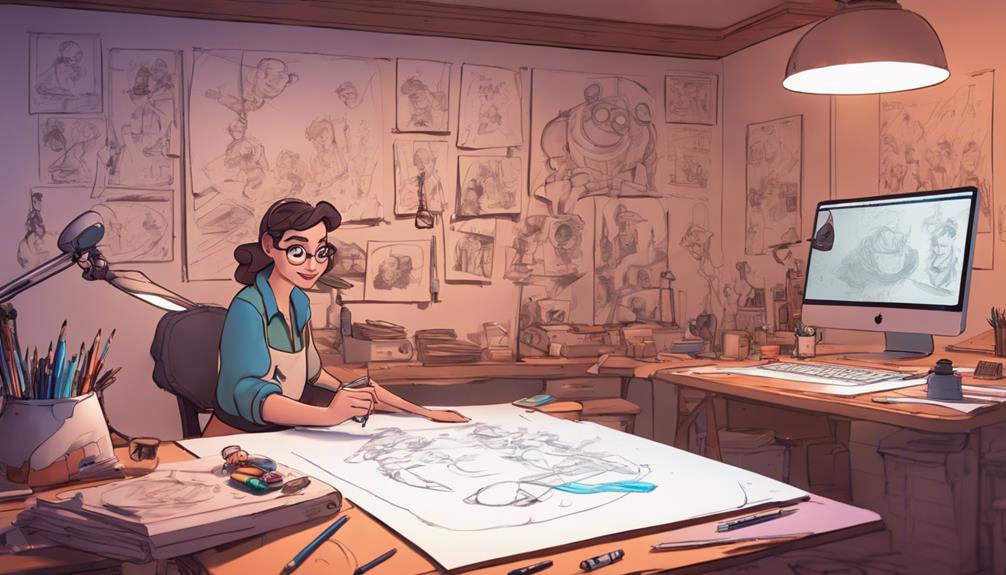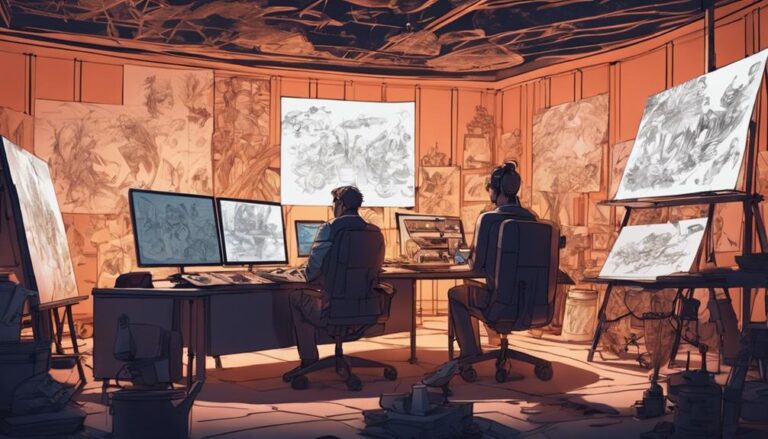5 Techniques to Bring Animated Characters to Life
When animating characters, you'll bring them to life by developing a rich backstory, crafting believable character motions, expressing emotion through animation, creating authentic character voices, and adding depth with subtle details. Start by crafting a detailed history, including cultural influences and life experiences, to inform your character's personality and behaviors. Then, use techniques like motion capture and physics-based simulations to create authentic movements. Facial cues, eyebrow movements, and eye contact will convey emotions, while unique vocal patterns and speech styles will make each character distinct. Dive deeper into these techniques to unlock your characters' full potential.
Key Takeaways
- Develop a rich backstory to create a foundation for a character's personality, motivations, and behaviors.
- Combine keyframe animation and motion capture techniques to create authentic character movements.
- Use facial cues, such as eyebrow movement and mouth shapes, to convey emotions and reveal a character's emotional state.
- Craft unique vocal idiosyncrasies, such as speech patterns, tone, and pitch, to make each character distinct.
- Add subtle details, such as facial tics and environmental interactions, to elevate characters from two-dimensional caricatures to living beings.
Developing a Rich Backstory
One of the most critical steps in bringing animated characters to life is crafting a rich backstory for each of them.
As you develop your character's history, you'll create a foundation for their personality, motivations, and behaviors. This backstory will also inform their character arcs, helping you to craft a narrative that's authentic and engaging.
When crafting a backstory, consider the cultural influences that have shaped your character's life.
Think about the time period, location, and social context in which they grew up. How have these factors influenced their values, traditions, and worldview? For example, a character from a collectivist culture may prioritize group harmony over individual achievement.
As you delve deeper into your character's backstory, you'll begin to uncover the complexities and nuances that make them relatable and believable.
You'll discover their strengths and weaknesses, their passions and fears. By understanding your character's history, you'll be able to create a more authentic and engaging performance.
Crafting Believable Character Motions
As you breathe life into your animated characters, it's essential to craft motions that not only reflect their personality but also convey their emotions and intentions.
To achieve this, you can combine traditional keyframe animation with motion capture techniques. By recording real-life performances, you can capture subtle nuances and translate them into authentic character movements.
When using motion capture, it's crucial to consider the character's physical properties and how they interact with their environment.
Physics-based simulations can help create realistic movements, such as the way clothing flows or how objects respond to gravity. This approach ensures that your characters' motions are grounded in reality, making them more relatable and engaging.
To refine your character's movements, focus on their center of gravity, weight distribution, and momentum.
These elements will help you create a sense of fluidity and naturalism in their actions. By mastering these techniques, you can craft believable character motions that draw your audience into the world you've created.
With practice and patience, your characters will come alive with a sense of authenticity that captivates and inspires.
Expressing Emotion Through Animation
Facial cues can be particularly effective in conveying emotions, as they can be incredibly nuanced.
They can be incredibly nuanced.
- Eyebrow movement: A raised eyebrow can convey surprise or curiosity, while a furrowed brow can indicate concern or frustration.
- Mouth shapes: A subtle curve of the lips can suggest a smile or a smirk, while a downturned mouth can indicate sadness or disappointment.
- Eye contact: Direct eye contact can convey confidence or intensity, while avoiding eye contact can suggest shyness or nervousness.
Creating Authentic Character Voices
When bringing animated characters to life, you'll find that their voice is just as crucial as their visuals in conveying their personality and emotional depth.
A well-crafted voice can transport your audience to a world of wonder and magic, making your characters feel more relatable and authentic.
As an animator, you can create authentic character voices by paying attention to vocal idiosyncrasies – the unique speech patterns, tone, and pitch that make each character distinct.
Listen to how people speak in real life, taking note of the way they pause, stutter, or emphasize certain words.
You can also experiment with different accents, dialects, and cadences to add depth and nuance to your characters' dialogue.
Dialogue patterns are also essential in crafting authentic character voices.
Think about how your characters interact with each other – do they interrupt, finish each other's sentences, or use sarcasm?
By paying attention to these subtle details, you can create a rich and immersive world that draws your audience in.
Adding Depth With Subtle Details
Adding Depth With Subtle Details
Subtle details are the unsung heroes of character animation, elevating your creations from two-dimensional caricatures to living, breathing beings.
You can achieve this by incorporating nuances that make your characters relatable and authentic. Facial tics, for instance, can reveal a character's emotional state or personality. A slight twitch of the eye or a raised eyebrow can speak volumes about their thoughts and feelings.
To add depth to your characters, focus on the following:
- Environmental interactions: Show how your characters interact with their surroundings. Do they fidget with objects, or do they've a favorite spot to sit?
- Micro-expressions: Incorporate subtle facial expressions that reveal a character's emotions. A fleeting smile or a flash of anger can add depth to their personality.
- Posture and body language: Use body language to convey a character's mood or attitude. A slouched posture can indicate sadness, while an open and expansive posture can suggest confidence.
Frequently Asked Questions
Can Animated Characters Be Based on Real People?
You can create animated characters based on real people, drawing from real inspirations like historical figures or everyday individuals. Some characters even resemble celebrity doppelgangers, making them instantly relatable and engaging to audiences worldwide instantly.
How Long Does Character Development Usually Take?
You spend months crafting character arcs, but the real challenge lies in weaving in Backstory depth – a process that can take years to perfect, as you layer nuanced traits and motivations into your character's psyche.
What Software Is Used for Animation Creation?
You're diving into animation creation, and the right software is key. You'll find Blender, a free, open-source animation software, is a popular choice, with numerous tutorials available to help you master its tools and tricks.
Can Voice Actors Improvise Character Lines?
You'll find that voice actors often crave vocal freedom. While some shows allow script deviation, others require strict adherence to the script. You'll need to consider the tone and style of your show to decide.
Are Animated Characters Copyrighted Automatically?
When you create an original character, intellectual property rights typically kick in, granting you legal protections and creative freedom. However, registering your work can further solidify artistic ownership and safeguard your unique concept.
Conclusion
You've brought your animated characters to life with a rich backstory, believable motions, and authentic voices. Emotions now radiate through their animations, drawing your audience in. But it's the subtle details that add the final layer of depth, making them relatable and real. With these techniques mastered, your characters will leap off the screen, captivating viewers and leaving a lasting impression. Your animation is now more than just a visual experience – it's a connection.







